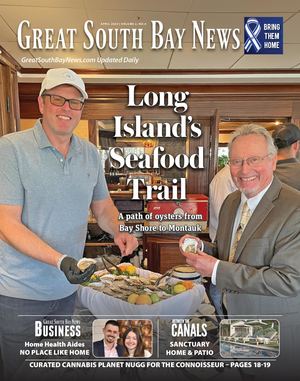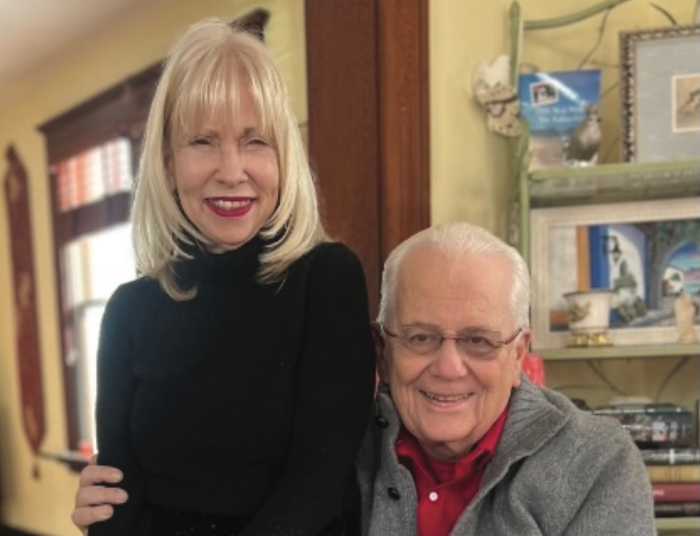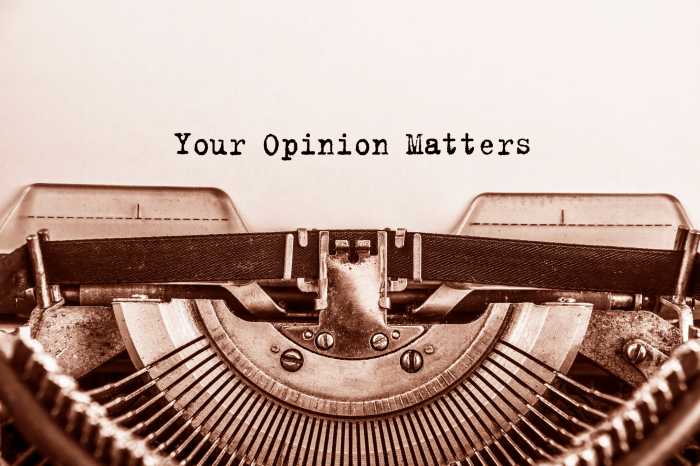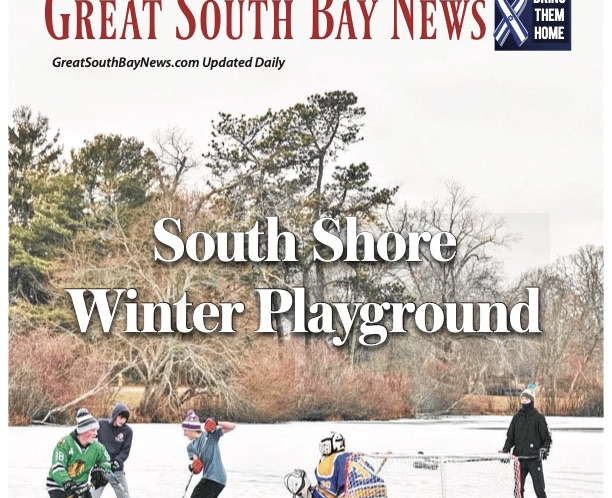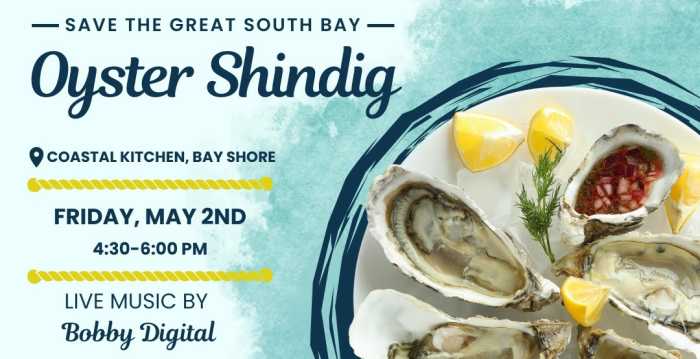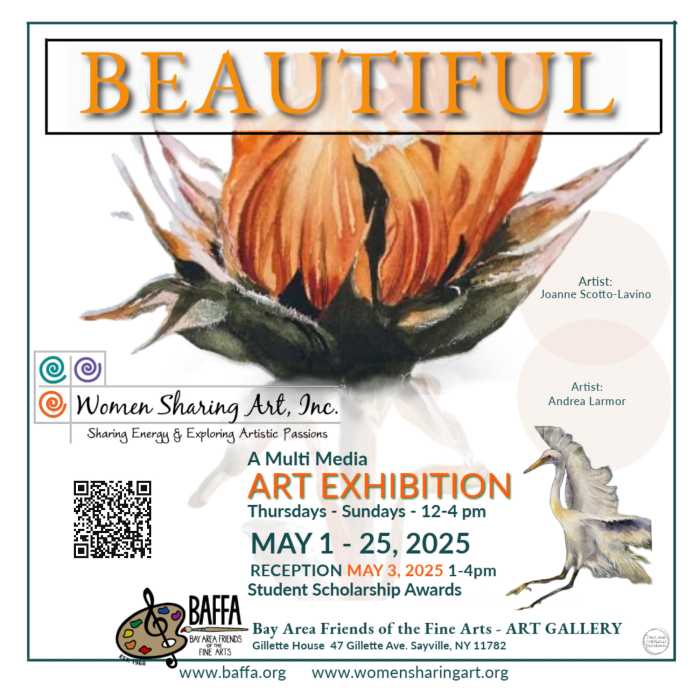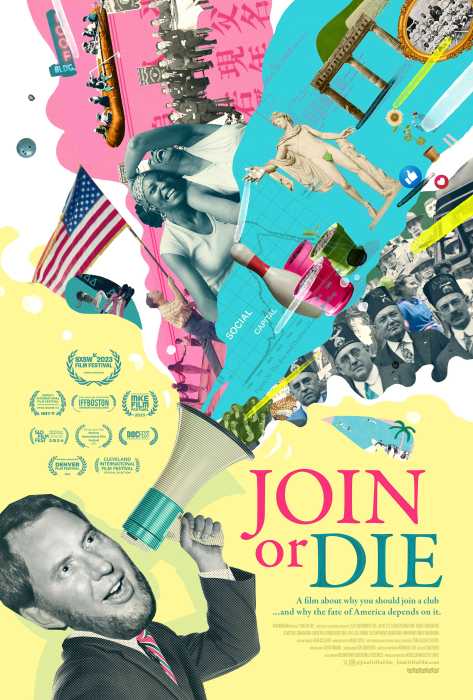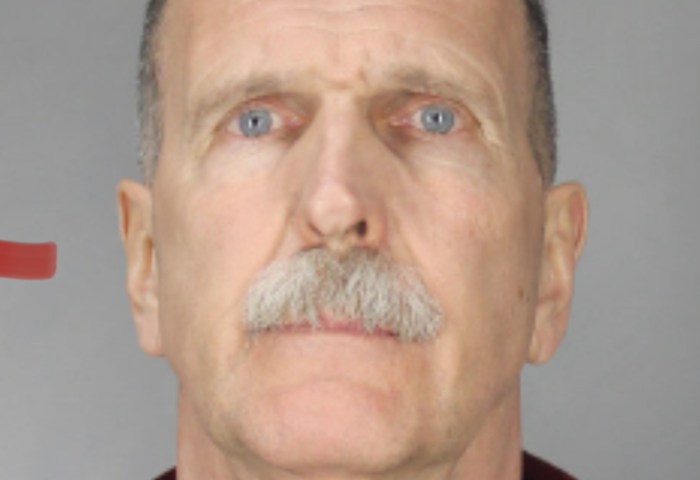By Shoshanna McCollum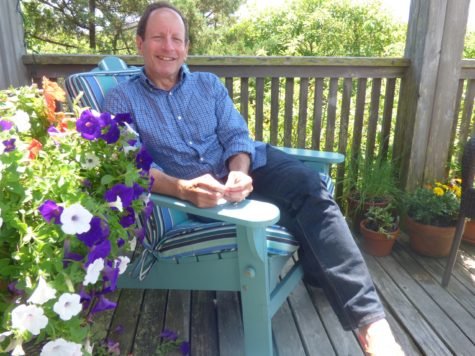 Many of us know Bill Goldstein from his popular morning television program segment, “Bill’s Books” on WNBC’s “Weekend Today in New York.” However this is just one aspect of a rich career cultivated by the self-described man who loves books. The 57-year-old Goldstein is a Brooklyn native who grew up in Sheepshead Bay. He and Blake West, his partner of 21 years, have summered in Fire Island Pines since the mid-1990s. After years of reviewing books authored by others, his debut title, “The World Broke in Two: Virginia Woolf, T.S. Eliot, D.H. Lawrence, E.M. Forster and the Year that Changed Literature,” was released Aug. 15 with Harry Holt Publishing. We sat down with Mr. Goldstein on the deck of his lovely Fire Island home to hear his story.
Many of us know Bill Goldstein from his popular morning television program segment, “Bill’s Books” on WNBC’s “Weekend Today in New York.” However this is just one aspect of a rich career cultivated by the self-described man who loves books. The 57-year-old Goldstein is a Brooklyn native who grew up in Sheepshead Bay. He and Blake West, his partner of 21 years, have summered in Fire Island Pines since the mid-1990s. After years of reviewing books authored by others, his debut title, “The World Broke in Two: Virginia Woolf, T.S. Eliot, D.H. Lawrence, E.M. Forster and the Year that Changed Literature,” was released Aug. 15 with Harry Holt Publishing. We sat down with Mr. Goldstein on the deck of his lovely Fire Island home to hear his story.
Fire Island News (FIN): So people call you Bill, not William?
Bill Goldstein (BG): I go by the name Bill, not William – some people are disappointed, but most people in the end call me Billy anyway.
FIN: Tell me a little bit about the young Bill Goldstein growing up in Brooklyn, New York.
BG: I was very strange child. My father died when I was 9 years old. He had been a big book collector, not rare books, but the writers of his time – Norman Mailer, Phillip Roth, Saul Bellow – he kept floor-to-ceiling bookshelves that were two rows deep. I spent a lot of time with those books. At the age of 15, I started to buy my own books. I would shop all the bookstores that were along 5th Avenue at the time – Brentano’s, Doubleday – so at 16 my mother gave me a subscription to Publishers Weekly as a birthday gift. A trade publication is an unusual gift for a teenager, but I read it right through college. During my junior year at University of Chicago, I read an article in their magazine that credited the assistance of an intern in the byline. So I wrote them asking about their internship program and I got a call. It was not a very robust program, they brought in interns only occasionally, but I was accepted. Upon graduating college, someone at Publisher’s Weekly had just quit, so I was offered a position. Now at my apartment in the West Village, I have floor-to-ceiling bookshelves, two rows deep just like my father’s. I’ve been a book lover since I was young. I was always a reader because of my father. My life has been shaped by my father’s love of books, and my entire career grew from that.
FIN: Okay, from Brooklyn to Fire Island. Of all the many options in which you could have purchased a summer home, why did you choose Fire Island Pines?
BG: It was kind of an accident. I never was a person with a five-year plan. I was in a different relationship at the time, and after almost eight years we broke up in 1993. I was invited to a Fire Island house share the following summer in 1994. Up until then staying on Fire Island never really occurred to me. It was a big share house, and except for my friend Adam, everyone else in that house was new to me. I was 34 then, and everything evolved from there. Some of the people in my house now still share together 24 summers later. Long-term friendships exist here on Fire Island. So I grew to love Fire Island. Friendships have endured here.
FIN: I understand you were one of the founding editors at The New York Times Book Review website. How did that come to be?
BG: Like I said, I never made a five-year plan. Before The New York Times, I was briefly an assistant book editor at Newsday, but that did not last very long. After that I went back to publishing as an acquiring editor at Scribner’s, but I realized it was a detour, I knew I was a journalist at heart. Then a friend of mine who worked at Delphi Internet, Rupert Murdoch’s first online company, recommended me in 1995. Online companies were still very new, and the venture ended unceremoniously. After everyone was laid off, another friend on the business side of The New York Times suggested I work for their online company, which was launched in 1996. Its major presence was on AOL, which is how things worked back then. Ultimately The New York Times was seeking to expand the online Book Review, their own web site, which was launched in 1997, which eventually lead to “TimesTalks” in 2006. It all happened by accident, and it was so strange how it came together so easily. I continued to work at The New York Times one way or another through 2010.
FIN: What then brought you to “NBC Today in New York”?
BG: Again this was an accident. Around the year 2000 someone from The New York Times conceived of cross promotion with NBC, which would have included segments about arts and theatre. NBC said ‘we have those people for that, how about books?’ It took time to work out details, but “Bill’s Books” first aired in 2000. It was supposed to be a six month experiment, but 17 years later here I am.
FIN: Now tell me a little bit about your work as curator of public programs with Roosevelt House at Hunter College?
BG: Another accident – I love this job! “TimesTalks” came to an end in 2010. A little before that, a woman I knew there who had been overseeing the “TimesTalks” program moved on to work at Hunter College. She did not stay at Hunter very long, but Roosevelt House was looking for someone to do public talks, and she recommended me. As a grad student and CUNY teaching fellow for the past three years, it was natural for me to take it on. It combined my love of both journalism and teaching, and I’ve worked there ever since. Roosevelt House has a complicated history. Mrs. Sara Delano Roosevelt bought the townhouse on 65th Street as a wedding present for her son Franklin and bride Eleanor. She also built an adjoining townhouse for herself next door. Hunter bought the houses from the family in 2008. The president of Hunter wanted to reopen it as a public policy institute. For me, the timing was perfect. It’s a great place.
FIN: From your biography, I see that you earned your Ph.D. from City University of New York Graduate Center in 2010. You were already well established in your career by then. What made you go back to school?
BG: Going back to school was kind of a lark. I went back to school with the idea that I should be reading more seriously, so I earned my Ph.D. in literature in 2010. I wrote a dissertation about Milton, but it has not been published. I guess that was my dry run. I had read Proust when I was younger, but while reading Proust again in class, I began wondering what Virginia Woolf thought of Proust. While not related to my graduate degree, I started researching her letters, and that became the germ of the book. So I had the idea in my 30s, but started working on it in my 50s. It took me six, almost seven years to write. Even though I worked in publishing, I never quite realized how much research there was to prepare a book. I learned so much more about 1922 than I ever imagined. Of course the struggle is to say it in a way that is accessible, not obscure.
FIN: I must say you took on a big project for a first book. I mean you did not write a romance novel, you started with Proust.
BG: Virginia Wolf hesitated to begin with Proust, but began to fall in love with it. She began that same year to read “Ulysses” by James Joyce, and she hated it. It was very interesting to see it through her eyes. Both are intimidating writers, but if you could read them through her eyes perhaps they would be less so, if you could see what she saw, her subjective and dramatic reactions to them. In 1922 Virginia Woolf, T.S. Eliot, D.H. Lawrence, and E.M. Forster each felt they had failed in their writing. Perhaps it could be easier to maybe not identify but understand them if we could see these great writers struggling with their own works. I thought it would work if the readers approached these books as we see the writers doing – beginning them. I hope you don’t have to read “A Passage to India” to understand Forster’s early work on it, or to have read “Mrs. Dalloway” to see it through Virginia Woolf’s eyes as she began it. As for my own struggle in writing this book, I often asked myself is there anything new that can be said about these great writers.
FIN: Is Virginia Woolf a hero of yours?
BG: I had read Virginia Woolf, but never very carefully. It was “The Hours” by Michael Cunningham that brought me back to her. I started seeing connections. Her struggle is something we can all understand. You see her struggles to be a great artist. It makes her so human. In spite of the fact that she committed suicide, for most of her life she triumphed over difficulties of the page. In her diaries she is open about her struggles as well as her joy. Suicide obscures the fact that she was also very funny. Her self-awareness is also both a plus and a minus for her. She was also friends, in a complicated way I wanted to explore, with T.S. Eliot and E.M. Forster. She is one of the greatest writers of the 20th century. What led me to Virginia Woolf led me to the other writers. At the heart of it everyone recognized her as the center of the Bloomsbury literary universe. In Virginia Woolf’s own time, some revered her, while others thought of her in a far less kindly way.
FIN: I take what I said back. To some degree this sounds like a romance to me.
BG: Love may not be the right word, but revered. What led to these great works of literature? What I hoped to do in seeing their life unfold in a narrow period of time is see the glimmers of the books in their mind, so we can approach these titles with less difficulty. So yes it is a romance. You aspire to understand them; what I discovered was they all had struggles in private lives too. Virginia Woolf, T.H. Lawrence, and T.S. Eliot they all had unusual marriages and I try to chronicle what made them unique. So it’s really four romances that play out differently, both fulfilling and empty due to the romantic choices they make. E.M. Forster was gay and lived with his mother. In 1922 Forster had fallen in love during World War I with an Egyptian tram conductor named Mohammed el Adl. But he rarely saw this man – some meetings lasted only a few hours. Mohammed was married, and it was not a natural relationship. Forster was so in love with this person, but also aware it was an illusion. In 1922 Mohammed was dying of consumption. Forster becomes impatient for Mohammed to die so he can move on.
FIN: In the Q&A that your publisher sent me you mention “uncanny political parallels to this moment in 2017. Can you elaborate please?
BG: I was working on this book for six or seven years. Even as I was finishing it up last year, I did not see a political relevance. Titles like “The Waste Land” and “Women in Love” are still read today. One of the centerpieces of the book, in July of 1922, the New York Society for the Suppression of Vice is at its height, its leader was John Sumner. They policed picture postcards, graffiti, and other suspicious activity. They took their name very seriously. In 1922 John Sumner seized three books, including “Women in Love” from Thomas Seltzer, a Jewish man. Censorship and anti-Semitism became ongoing themes with the book.
Over the past year we became more aware of anti-Semitism as a continuing strain, expressed be it openly or coded, coming to the fore. A lot of what was happening in the 20s is not uniquely against Jewish publishers, but publishers like Horace Liveright were perennial targets, as did other New York publishers receive more than their fair share. Partly because as younger publishers they were making more daring choices, and printing more sexually frank literature.
Today there is still much talk of censorship. There is a reason we mark banned books week. The risk of censorship is always greater when politically correct speech is used to champion free speech, but on both extremes used to suppress discussion that does not fit what is considered appropriate public discourse.
We have to be aware there have always been government and quasi-government entities trying to control what people should read. The triumph in 1922 was a major decision the New York Court of Appeals decided, you could not ban books as obscene based on isolated passages. That kind of test could apply to the Bible the court pointed out. After that ruling “Women in Love” could be sold openly. It became a bestseller and the only time D.H. Lawrence made money.
The danger is we can’t ever forget about censorship. Even if we are not trying to suppress what adults are reading, we are much still trying to control what young adults read, what college students read. Who is the guardian of what people should read or see? It surprises me to see in 2017 that the question is still so persistent.
FIN: Is there anything you wish to add to this interview that my questions have not touched on?
BG: Having my editor edit the book, sometimes less is more. From an academic and journalistic point of view, you move from quote to quote to buttress an idea. What I realized in writing this book is sometimes it is actually more potent to have one person make the point rather than have an echo reinforce and actually weaken the point.
I learned how to write from my entire career. I’m very grateful to people and colleagues along the way. Because of them I’m a great believer in internship programs and networking. An interest in books is not often regarded as a first qualification, but it has brought me to many different places.
FIN: We make our own luck.
BG: But I did not struggle like Virginia Woolf or E.M. Forster. My father’s love of books grows from that fact. My mother and three older brothers often say how proud he would have been.
“The World Broke in Two: Virginia Woolf, T.S. Eliot, D.H. Lawrence, E.M. Forster and the Year that Changed Literature” is available for sale at all major book retail outlets.
